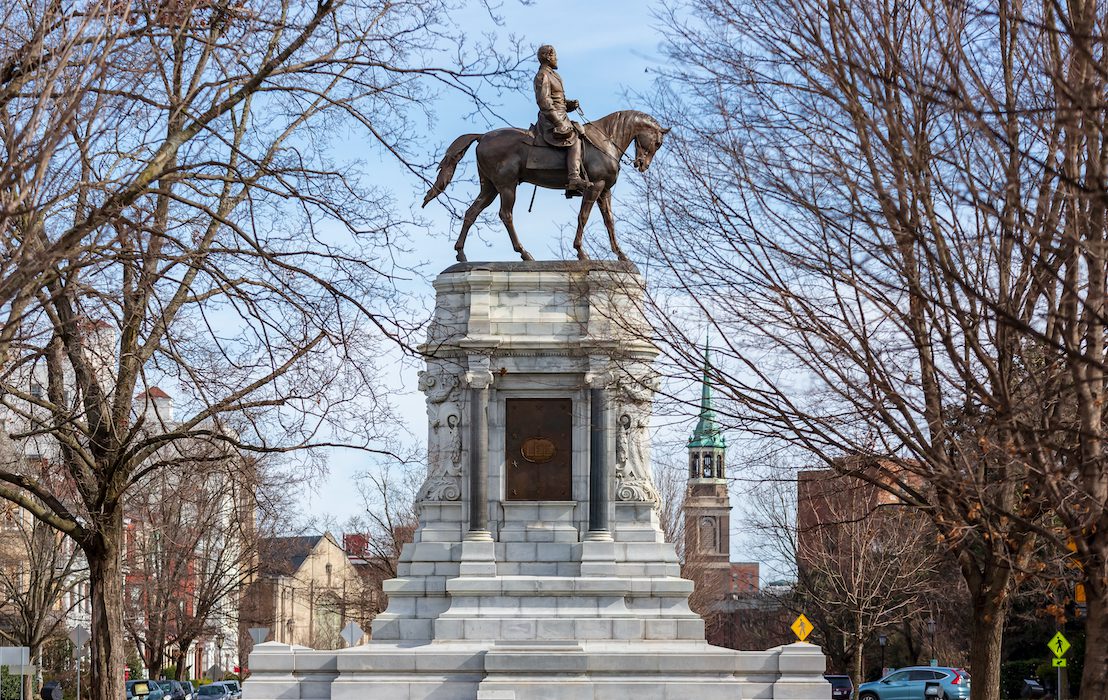
www.theamericanconservative.com
America’s Last Englishman
Books
America’s Last Englishman
A new book examines the ever-fascinating Marble Man.
Robert E Lee: A Life, Allen Guelzo, Alfred A. Knopf, 588 pages
I first moved to Richmond Virginia, escaping the murmurs of a nascent statue-toppling cultural revolution in England, in the immediate aftermath of the 2020 cultural revolution in America, and the Monument Avenue of Richmond, once a proud host of several pristine statues, looked somewhat similar to Palmyra in Syria après ISIS. The Robert Edward Lee statue that was in the middle of the road was a giant cratered husk, its surrounding park graffitied with incoherent, semi-literate obscenities. Within three years, his namesake university would remove the plaque and headstone of his horse.
Unpersoning controversial figures (or even their beasts of burden) from history is arguably the primary marker of an unconfident and uncivilized nation, but even by that measure, the particular fanaticism against Lee defies logic, as it is so vehemently ahistorical and primal. Lee demands strong reactions, mostly by those who are utterly ignorant about him, good or bad. Scores of overtly online first generation migrants to this country routinely denounce him as a traitor to the “idea of America” demanding that all traces of him should be removed from public life; which in itself is absurd, if one compares them to those who actually fought him or lived in the aftermath of the civil war.
Consider this particular assessment. “Lee was, in my estimation, one of the supremely gifted men produced by our Nation. He believed unswervingly in the Constitutional validity of his cause which until 1865 was still an arguable question in America; he was a poised and inspiring leader, true to the high trust reposed in him by millions of his fellow citizens; he was thoughtful yet demanding of his officers and men, forbearing with captured enemies but ingenious, unrelenting and personally courageous in battle, and never disheartened by a reverse or obstacle.”
That was Dwight D. Eisenhower in a letter to a student of his time, one who even then, similar to most students now, did not possess the intellectual depth or moral gravitas in differentiating and judging the man separate from the circumstance. Eisenhower, no neo-Confederate himself, continued, “Through all his many trials, he remained selfless almost to a fault and unfailing in his faith in God. Taken altogether, he was noble as a leader and as a man, and unsullied as I read the pages of our history.”
My original interest in Lee was tangential and not solely because I am newly assimilated to his native land. I am academically interested in the subject of “proclamations of neutrality,” a strategic posture, often used in history by smart great powers to stay away from peripheral conflicts, back when boundaries and borders were important, and the world wasn’t a giant human-rights covered NGOcratic glob for every whiggish busybody to interfere everywhere. Prudential American presidents used it repeatedly, from Washington (in France), to Grant (Prussia) and Theodore Roosevelt (during the Russo-Japanese war). But most famously it was used by Great Britain to declare neutrality in the American civil war, a war “between cousins,” where the British people were allowed to aid and battle on behalf of whichever side they so chose depending on their personal morality.
Palmerston and the British aristocracy had no fellow feeling for the ultra-puritan, ultra-republican North, and shared stronger bonds of kinship, temperament, and high-Anglican culture with the landed gentry of the South. And yet the Southern strategy of involving Britain failed. Chastised in Crimea and India half a decade earlier, London had no appetite for another civil war in another theater and no intention of being enmeshed with the involvement of rivals such as France. Instead London chose to focus on consolidating the empire. Worried about revolutionary instincts and the mass opposition to slavery, Britain was pragmatic enough to actively allow British subjects to go and join any conflict as well as profit from any war, to satiate their martial cravings. Lincoln, the tyrant who destroyed habeas corpus per some British elites, won the war and changed the character of the republic permanently, and Lee, the last true Englishman of America, to channel Lord Robert Cecil, lost the civil war, and accordingly, the subsequent war of narrative and history.
It is difficult to find decent biographies of Lee; older ones are either too hagiographic, or per modern sensibilities determined by publishing houses to be unimportant enough to be out of print permanently, and newer ones are ritualistically inculpatory of him. It might prove to be career destroying for modern academic historians to be truly revisionist about the man. So credit goes to Allen Guelzo to even attempt to bridge that with his Robert E. Lee: A Life. Guelzo admits his bias right off the bat. He is a northerner and trained to regard Lee as a traitor. Guelzo, however, attempts to study Lee’s motivations, and not just his actions right or wrong. That itself gives the book a new character. Whether the evidence and assertions are true or false is a different question; historiography is rarely monocausal or objective. But it is a unique attempt.
Guelzo admits that Lee was recorded as a decent and noble man even by his contemporaries and adversaries, a sense of Christian charity and sensibility towards opponents that we now have lost. He cites Abraham Lincoln who remarked that Lee was “noble and brave,” and Ulysses Grant, who wondered how he looked next to a man of “much dignity” and “handsomely dressed, six feet high and faultless form.” Even in defeat, Lee maintained “manly decorum” and came “dressed in full uniform which was entirely new” and wearing a “sword of considerable value.”
Chivalry, pedigree, decorum, and class are things few people inherit, and the descendant of revolutionary war hero Henry “Light Horse Harry” Lee III had that in his blood. Guelzo admits that “no one who met Robert Edward Lee—no matter what the circumstances of the meeting—ever seemed to fail to be impressed by the man. His dignity, his manners, his composure, all seemed to create a peculiar sense of awe in the minds of observers.”
So why did the man, whose haunted stoic face we see adorned similar to an Orthodox saint in the pages of history, decide to take up arms against his country? Guelzo traces that to three psychological instincts, his desire for independence, security, and perfection, “all three rooted in the early trauma inflicted by one of the more remarkably dysfunctional families of the early republic.” Lee wanted to fulfill the life he never had due to the abandonment of his father. Every single major act in his life, from joining the army as an engineer to his ideas about slavery, to his love for Virginia, to his war on his revolutionary forefather’s flag stemmed from that. Guelzo writes, “He would sacrifice himself in order to perfect the imperfections Light Horse Harry had visited on the Lees.” Lee was determined to not be his father, and in that urge, he was visited by “his ferocious outbursts of temper at his own and others’ imperfections.”
The trouble with psychological analysis is that it is not objective. Guelzo, despite his attempt to ensure some neutrality, partially fails the task that he explicitly put to himself. For example, Guelzo admits that Lee was not ambivalent about the practice of slavery and in fact considered it a “moral and political evil” that, however, he was willing to let God solve in His own time. Lee wasn’t a bigot, despite the fact that he shared the attitudes of his time on cumulative racial disparities. Is that wrong? I am not sure I am qualified to judge the prevalent attitude of an age, as a historian. What can be judged are Lee’s recorded actions. “He funded the expatriation of slaves from Arlington who agreed to resettle in the American Colonization Society’s West African outpost of Liberia and in 1862 completed the emancipation of the Custis slaves (which he was obligated to do by his father-in-law’s will) and then freed his own (which he was not).” After the war, as president of Washington College, he strictly prevented racial violence against freedmen.
Guelzo also demonstrates how Lee was appalled at the violence against radical anti-slavery activists. Lee simply preferred order. Guelzo then proceeds to show how Lee was temperamental and had two slaves whipped for trying to flee. Guelzo’s sole evidence is the record of an abolitionist newspaper that Lee lost temper and flayed his wayward slaves. Lee’s own words addressing that episode were a curt refusal to reply. One is not sure how neutral the narrative or how sound that evidentiary criteria are, when the claims of a radical newspaper are considered an ultimate arbiter of truth in a classic “both said” scenario, especially when one can consider how Lee viewed the idea of Anglican honor, as evident from his previously recorded treatment in freeing other slaves.
Similarly, Guelzo states that Lee wasn’t profound. “His compulsive letter writing betrays little evidence of reading beyond the demands of his profession. But he was a clear thinker, and much of that thinking oscillated within the poles he had set up for himself of perfection, independence, and security.” It is an interesting circular reasoning, as situational clarity without profundity is arguably impossible. It is even more absurd, as Guelzo demonstrates Lee’s logical reasoning during the war. “Lee saw more clearly than any other Confederate leader that the South could not survive a long-drawn bout with the North. Southern armies must move across the Potomac and there persuade Northerners, either by battle or by simple occupation, to agree to peace and Southern independence. He would attempt this twice, in 1862 and 1863, and was ready for a third attempt in 1864 when Grant’s Overland Campaign struck that option away.”
Lee foresaw the loss as he understood the value of Richmond. “With Richmond would go Virginia and then the Confederacy—which, in 1865, is exactly what happened.” Is that logic lacking intellectual depth or historical knowledge of warfare? I suggest the readers to judge themselves reading Lee’s letters, in Elizabeth Brown Pryor’s magisterial study Reading the Man: A Portrait of Robert E. Lee Through His Private Letters.
Guelzo is a beautiful writer, and for that one can be thankful as historical writing that is also beautiful literature is increasingly a lost art. His depiction of Lee’s visit to Stratford, and his father’s grave, after his father’s death has a Orson Wellesian feel to it. Lee’s death itself was haunting. But most poetically, Lee found satisfaction in the final years of his life. Guelzo writes, “Perhaps, in retrospect, we can say that Robert Lee should have shrugged off the shadow of Light Horse Harry; perhaps he should have left the Army and built a real estate empire in western Virginia; perhaps he should have become the handsome but aloof family overseer of Arlington and let the Civil War and the taint of treason wash past him. But he did not, and the forces that had made him what he was in the past governed the extraordinary skill with which he managed Confederate military affairs. They did not, however, make him a happy man. That only came at the end, in Lexington. But it was, for him, a perfect end.”
The word “treason” is jarring in that otherwise ornamental paragraph. Was Lee guilty of treason? One might argue, as much as George Washington himself, a name he shares at a university and a name under whose banner his forefathers fought in the revolutionary war. There was no idea of national unity then anyway, and even the military oath was to a Union of States, arguably closer to the founders’ visions of a minimalist federal republic where supreme loyalty from the residents was towards their states.
Whether it was a sustainable vision, I am not sure. Republics are notoriously difficult arrangements to keep and maintain, their historical ends caused foremost, among others, due to a lack of order, which also paradoxically leads to further erosion of republican norms. History is interesting that way, opinions change with time. How the northern European barbarians viewed the Roman empire is different than how we view it now, just as how we view the British empire will be different in three to five hundred years’ time. If the fate of every republic is to inevitably overcome its own contradictions and become an empire, then for good or for bad, it was Lincoln who started that consolidation process and it was Lee who rebelled against it clasping to a higher ideal.
Regardless, Guelzo’s book is a worthy addition in the historiography of the Confederates. One only wishes there were more revisionist and neutral studies of that period and those men, and not fewer. As for Lee, one of the complex, imperfect, haunted, great men of history, the verdict of history itself will continue to be more nuanced than contemporary historians, for as long as there are other men who will continue to be fascinated about tortured great men from the past. As some of the Confederate graves in Richmond note, fate denied them victory, but in a strange way, granted them immortality.
The post America’s Last Englishman appeared first on The American Conservative.














